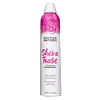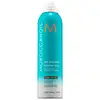What's inside
What's inside
 Key Ingredients
Key Ingredients

No key ingredients
 Benefits
Benefits

 Concerns
Concerns

 Ingredients Side-by-side
Ingredients Side-by-side

Sd Alcohol 40-B
AstringentHydrofluorocarbon 152a
Butyl Ester Of Pvm/Ma Copolymer
PEG/PPG-17/18 Dimethicone
EmulsifyingAminomethyl Propanol
BufferingPhenyl Trimethicone
Skin ConditioningPyrus Malus Fruit Extract
Skin ConditioningSaccharum Officinarum Extract
MoisturisingTrifolium Pratense Flower Extract
AstringentHoney Extract
HumectantBambusa Vulgaris Leaf Extract
Skin ConditioningPanthenol
Skin ConditioningWater
Skin ConditioningPropylene Glycol
HumectantTocopheryl Acetate
AntioxidantBenzophenone-4
UV AbsorberParfum
MaskingSd Alcohol 40-B, Hydrofluorocarbon 152a, Butyl Ester Of Pvm/Ma Copolymer, PEG/PPG-17/18 Dimethicone, Aminomethyl Propanol, Phenyl Trimethicone, Pyrus Malus Fruit Extract, Saccharum Officinarum Extract, Trifolium Pratense Flower Extract, Honey Extract, Bambusa Vulgaris Leaf Extract, Panthenol, Water, Propylene Glycol, Tocopheryl Acetate, Benzophenone-4, Parfum
Hydrofluorocarbon 152a
Butane
Oryza Sativa Starch
AbsorbentSd Alcohol 40-B
AstringentDisiloxane
Skin ConditioningArgania Spinosa Kernel Oil
EmollientPvp
Emulsion StabilisingWater
Skin ConditioningParfum
MaskingMagnesium Stearate
Cosmetic ColorantDiisopropyl Adipate
EmollientCetrimonium Chloride
AntimicrobialMethoxycinnamidopropyl Hydroxysultaine
UV AbsorberCI 60725
Cosmetic ColorantCI 17200
Cosmetic ColorantIngredients Explained
These ingredients are found in both products.
Ingredients higher up in an ingredient list are typically present in a larger amount.
We don't have a description for Hydrofluorocarbon 152a yet.
Parfum is a catch-all term for an ingredient or more that is used to give a scent to products.
Also called "fragrance", this ingredient can be a blend of hundreds of chemicals or plant oils. This means every product with "fragrance" or "parfum" in the ingredients list is a different mixture.
For instance, Habanolide is a proprietary trade name for a specific aroma chemical. When used as a fragrance ingredient in cosmetics, most aroma chemicals fall under the broad labeling category of “FRAGRANCE” or “PARFUM” according to EU and US regulations.
The term 'parfum' or 'fragrance' is not regulated in many countries. In many cases, it is up to the brand to define this term.
For instance, many brands choose to label themselves as "fragrance-free" because they are not using synthetic fragrances. However, their products may still contain ingredients such as essential oils that are considered a fragrance by INCI standards.
One example is Calendula flower extract. Calendula is an essential oil that still imparts a scent or 'fragrance'.
Depending on the blend, the ingredients in the mixture can cause allergies and sensitivities on the skin. Some ingredients that are known EU allergens include linalool and citronellol.
Parfum can also be used to mask or cover an unpleasant scent.
The bottom line is: not all fragrances/parfum/ingredients are created equally. If you are worried about fragrances, we recommend taking a closer look at an ingredient. And of course, we always recommend speaking with a professional.
Learn more about ParfumSD Alcohol 40-B is created by denaturing ethanol with tert-Butyl alcohol and denatonium benzoate. It is a solvent and astringent.
The 'SD' stands for 'specially denatured'. Denatured alcohol means the structure has been altered.
The 40-B is given by the U.S. Bureau of Alcohol, Tobacco, and Firearms. This is in accordance to the method of how the alcohol was denatured.
This ingredient is a solvent alcohol.
Learn more about Sd Alcohol 40-BWater. It's the most common cosmetic ingredient of all. You'll usually see it at the top of ingredient lists, meaning that it makes up the largest part of the product.
So why is it so popular? Water most often acts as a solvent - this means that it helps dissolve other ingredients into the formulation.
You'll also recognize water as that liquid we all need to stay alive. If you see this, drink a glass of water. Stay hydrated!
Learn more about Water